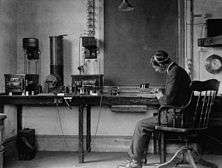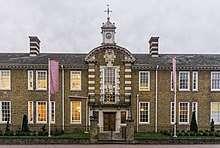Marconi Company
The Marconi Company was a British telecommunications and engineering company that did business under that name from 1963 to 1987. It was derived from earlier variations in the name and incorporation, spanning a period from its inception in 1897 until 2006, during which time it underwent numerous changes, mergers and acquisitions. The company was founded by the Italian inventor Guglielmo Marconi and began as the Wireless Telegraph & Signal Company. The company was a pioneer of wireless long distance communication and mass media broadcasting, eventually becoming one of the UK's most successful manufacturing companies. In 1999, its defence manufacturing division, Marconi Electronic Systems, merged with British Aerospace to form BAE Systems. In 2006, extreme financial difficulties led to the collapse of the remaining company, with the bulk of the business acquired by the Swedish telecommunications company, Ericsson.
| Private company | |
| Industry | Telecommunications |
| Fate | Acquired by GEC (1968) Renamed to GEC-Marconi Ltd (1987) |
| Predecessor | Wireless Telegraph & Signal Company (1897–1900) Marconi's Wireless Telegraph Company (1900–1963) |
| Successor | CMC Electronics (1903–present) GEC-Marconi Ltd (1987–1998) BAE Systems (1999 to present) Marconi plc (1999–2003) Marconi Corporation plc (2003–2006) Ericsson (2005 to present) Telent (2005 to present) |
| Founded | 1897 (as Wireless Telegraph & Signal Company) 1900 (as Marconi's Wireless Telegraph Company) 1963 (as Marconi Company Ltd) |
| Founder | Guglielmo Marconi |
| Defunct | 1987 (as Marconi Company Ltd) 2006 (as Marconi Corporation plc) |
| Headquarters | |
| Owner | English Electric (1946–1968) General Electric Company plc (1968–1998) Marconi plc (1999–2003) Marconi Corporation plc (2003–2006) |
History
Naming history
- 1897–1900: The Wireless Telegraph & Signal Company
- 1900–1963: Marconi's Wireless Telegraph Company
- 1963–1987: Marconi Company Ltd
- 1987–1998: GEC-Marconi Ltd
- 1998–1999: Marconi Electronic Systems Ltd
- 1999–2003: Marconi plc
- 2003–2006: Marconi Corporation plc
Early history


.png)
Marconi's "Wireless Telegraph and Signal Company" was formed on 20 July 1897 after the granting of a British patent for wireless in March of that year. The company opened the world's first radio factory on Hall Street in Chelmsford in 1898 and was responsible for some of the most important advances in radio and television. These include:
- The diode vacuum tube in 1904 (Fleming)
- Transatlantic radio broadcasting[1] between Clifden, Ireland and Glace Bay, Nova Scotia, October 17, 1907.
- High frequency tuned broadcasting
- Formation of the British Broadcasting Company (later to become the independent BBC)
- Formation of the Marconi Wireless Telegraph Company of America (assets acquired by RCA in 1920)
- Marconi International Marine Communication Co. (M.I.M.C.Co.), founded 1900 in London
- Compagnie de Télégraphie sans Fil (C.T.S.F.), founded 1900 in the City of Brussels
- Short wave beam broadcasting
- Radar
- Television
- Avionics
The subsidiary Marconi Wireless Telegraph Company of America, also called "American Marconi", was founded in 1899.[2] It was the dominant radio communications provider in the US until the formation of the Radio Corporation of America (RCA) in 1919.[3]
In 1900 the company's name was changed to "Marconi's Wireless Telegraph Company" and Marconi's Wireless Telegraph Training College was set up in 1901. The company and factory was moved to New Street Works in 1912, to allow for production expansion in light of the RMS Titanic disaster. Along with private entrepreneurs, Marconi company formed in 1924 the Unione Radiofonica Italiana (URI), which was granted by Mussolini's regime a monopoly of radio broadcasts in 1924. After the war, URI became the RAI, which lives on to this day.
In 1939, the Marconi Research Laboratories at Great Baddow were founded and in 1941 there was a buyout of Marconi-Ekco Instruments to form Marconi Instruments.
Operations as English Electric subsidiary

English Electric acquired the Marconi Company in 1946 which complemented its other operations; heavy electrical engineering, aircraft and its railway traction business. In 1948 the company was reorganised into four divisions:
- Communications
- Broadcasting
- Aeronautics
- Radar
These had expanded to 13 manufacturing divisions by 1965 when a further reorganisation took place. The divisions were placed into three groups :
- Telecommunications
- Electronics
- Components
At this time the Marconi Company had facilities at New Street Chelmsford, Baddow, Basildon, Billericay, and Writtle as well as in Wembley, Gateshead and Hackbridge. It also owned Marconi Instruments, Sanders Electronics, Eddystone Radio and Marconi Italiana (based in Genoa, Italy). In 1967 Marconi took over Stratton and Company to form Eddystone Radio.
Expansion in Canada
In 1903, Marconi founded the Marconi's Wireless Telegraph Company of Canada which was renamed as the Canadian Marconi Company in 1925. The radio business of the Canadian Marconi Company is known as Ultra Electronics TCS since 2002 and its avionic activities as CMC Electronics, owned by Esterline since 2007. [4]
Expansion as GEC subsidiary
In 1967 or 1968, English Electric was subject to a takeover bid by the Plessey Company but chose instead to accept an offer from GEC. Under UK government pressure, the computer section of GEC, English Electric Leo Marconi (EELM), merged with International Computers and Tabulators (ICT) to form International Computers Limited (ICL). The computer interests of Elliott Automation which specialised in real-time computing were amalgamated with those of Marconi's Automation Division to form Marconi-Elliott Computers, later renamed as GEC Computers. In 1968 Marconi Space and Defence Systems and Marconi Underwater Systems were formed.
The Marconi Company continued as the primary defence subsidiary of GEC, GEC-Marconi. Marconi was renamed GEC-Marconi in 1987. During the period 1968–1999 GEC-Marconi/MES underwent significant expansion.
Acquisitions which were folded into the company and partnerships established include:
- Defence operations of Associated Electrical Industries in 1968, AEI had been acquired in 1967.
- Yarrow Shipbuilders in 1985
- Ferranti defence businesses in 1990
- Ferranti Dynamics in 1992
- Vickers Shipbuilding and Engineering in 1995
- Alenia Marconi Systems in 1998, a defence electronics company and an equal shares joint venture between GEC-Marconi and Finmeccanica's Alenia Difesa.
- Tracor in 1998.
Other acquisitions include:
- Divisions of Plessey in 1989 (others acquired by its partner in the deal, Siemens AG, to meet with regulatory approval).
- Plessey Avionics
- Plessey Naval Systems
- Plessey Cryptography
- Plessey Electronic Systems (75%)
- Sippican
- Leigh Instruments
In a major reorganisation of the company, GEC-Marconi was renamed Marconi Electronic Systems in 1996 and was separated from other non-defence assets.
Marconi name today
In 1999 GEC underwent a major transformation. Marconi Electronic Systems which included its wireless assets was demerged and sold to British Aerospace which then formed BAE Systems.
GEC, realigning itself as a primarily telecommunications company following the MES sale, retained the Marconi brand and renamed itself Marconi plc. BAE were granted limited rights to continue its use in existing partnerships, however by 2005 no BAE businesses use the Marconi name. Major spending and the dot-com collapse led to a major restructuring of that group, in a debt-for-equity swap shareholders were given 0.5% of the new company, Marconi Corporation plc.
In 1999 Reltec and Fore Systems were acquired at the height of the "dot-com" boom. With its subsequent collapse the Marconi Corporation got into financial difficulties.
In October 2005 the Swedish firm Ericsson offered to buy the Marconi name and most of the assets. The transaction was completed on 23 January 2006 effective as of 1 January 2006. The Marconi name will still be used as a brand within Ericsson. At the time of the acquisition Ericsson announced that they would be rebranding Marconi assets Ericsson and retaining Marconi only as the name of the Italian research facility. However the company has since labelled its OMS line and its Long Haul Digital Radio system Marconi. The rest of the Marconi company was renamed as Telent.
See also
References
- Second Test of the Marconi Over-Ocean Wireless System Proved Entirely Successful. Sydney Daily Post. 24 October 1907
- Wilkins, Mira (1989). The History of Foreign Investment in the United States to 1914. Harvard University Press.
- Buckley, Peter J. European Direct Investment in the U.S.A. before World War I. Springer.
- Denis Couillard, Ultra Electronics TCS
- Baker, W. J. (1970, 1996) History of the Marconi Company 1894–1965.
External links
| Wikimedia Commons has media related to Marconi Company. |
- Ericsson press release about the acquisition
- Catalogue of the Marconi Archives At the Department of Special Collections and Western Manuscripts, Bodleian Library, University of Oxford
- Marconi Calling The Life, Science and Achievements of Guglielmo Marconi
- History of Marconi House